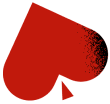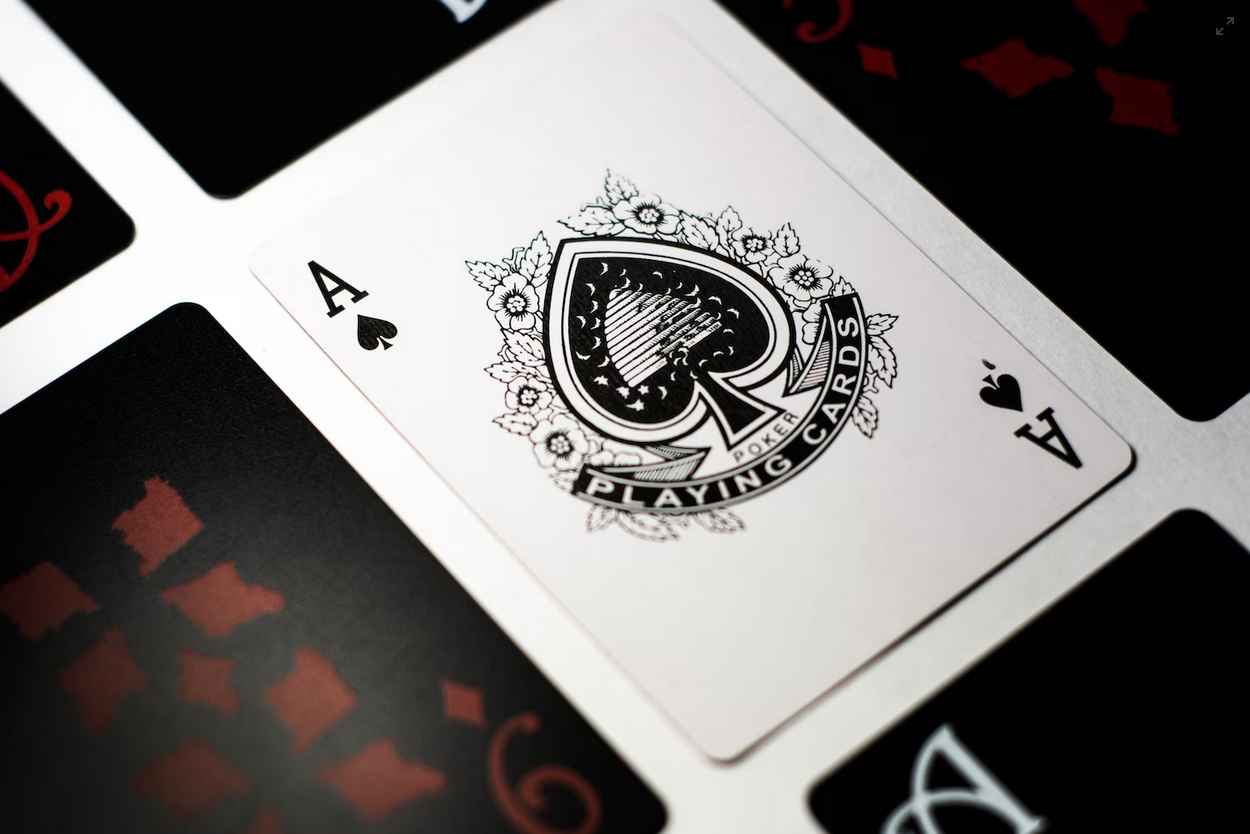
Não se Precipite no Jogo! Leia o Guia de Como Jogar Póquer para Iniciantes
Lições Antes de Entrar nas Mesas – Guia de Como Jogar Póquer para Iniciantes
Todos acham que aprender a jogar póquer é uma tarefa fácil. É verdade, mas apenas no que toca às regras básicas. Depois de dominar os conceitos básicos e de ter alguma prática, ficará a conhecer as diferenças entre as variantes de póquer e as regras básicas de jogo. Contudo, o jogo tal como ele é jogado implica conhecer muitas nuances. Por isso, todos lhe dirão coisas diferentes sobre o grau de dificuldade real sobre o jogo do póquer. Os profissionais dir-lhe-ão que tudo é uma questão de estratégia, e os jogadores casuais falam em intuição de jogo. Mas quando olha genuinamente para o que se passa nas mesas, reconhecerá que o jogo tem um grau elevado de complexidade, que alia estratégia, habilidade, conhecimento, sorte, e nervos de aço. Neste artigo debatemos algumas das dicas mais importantes que deve ter em mente para jogar póquer. Damos-lhe uma visão geral dos vários aspetos que tem mesmo de conhecer sobre o jogo, e mostrarmos-lhe como melhorar as suas capacidades em pouco tempo!

Os Passos Fundamentais que os Iniciados do Póquer Devem Implementar
O póquer é jogado em todo o mundo, mas continua a ser uma atividade estranha para várias pessoas. Todos os praticantes de póquer têm o seu próprio motivo para continuarem a jogar. Diferentes motivos significam diferentes formas de estar em jogo. Alguns querem a excitação e o alto risco envolvidos nas jogadas, outros adquirem uma mentalidade de estratégia e paciência. Outros ainda querem simplesmente fazer parte desta cultura de jogo.
Aquilo em que todos concordam é que jogar póquer pela primeira vez provoca imensa diversão. Mas é importante dominar as noções básicas de jogo para não perder dinheiro. Há várias regras, terminologia de póquer e até etiqueta que vale a pena conhecer antes de colocar a sua primeira aposta. Muitos apressam-se em decisões impulsivas, dizendo para si próprios que estão preparados. Infelizmente, estas pessoas costumam perder o seu dinheiro rapidamente. Porquê? Porque subestimam as possibilidades de vitória dos outros jogadores da mesa.
A maior parte das pessoas dir-lhe-ão que póquer demora poucos minutos a aprender, mas leva uma vida inteira a dominar. Porquê? Porque basta aprender as regras para começar a jogar, mas implica experiência real para conseguir começar a ganhar em jogos de póquer ao vivo.
Começamos sempre por abordar as regras básicas do póquer para os iniciantes, e à medida que continuar a jogar irá começar a reparar em aspetos comportamentais que influenciam as estratégias vencedoras. Esses detalhes podem ser qualquer coisa, desde a conversa que se tem na mesa entre jogadas, até à pressão que força ao folding nas mesas. Mas agora, vamos começar com os passos mais críticos de que se deve lembrar sobre o póquer.
#1. Aprenda Sobre a Classificação de Mãos no Póquer
Uma mão no póquer corresponde à combinação específica de cartas da comunidade (ou cartas “hole”) que são formadas por um jogador no início de um jogo. Cada mão em póquer terá uma classificação própria em função do valor das cartas que formam essa mão. Por isso, a regra número um do póquer é saber que mão ganha que outras combinações no póquer. Terá assim de tentar perceber se a sua mão é uma das mais fortes em jogo. Poderá encontrar a classificação das cartas e de combinações no póquer em baixo.
#2. Gerir a Sua Banca no Póquer
Quando começa a jogar póquer, pode ser tentador começar a apostar com dinheiro que não tem realmente. Mas se fizer isto, poderá perder mais do que pode gastar. Todos os jogadores de póquer devem compreender o conceito de gestão de banca. Os melhores jogadores de póquer preocupam-se em fazer uma gestão responsável do seu dinheiro. E só apostam o que estão dispostos a perder. Isto significa escolher cuidadosamente os seus buy-ins e os tipos de póquer a que se juntam. Por exemplo, os profissionais usam uma banca mínima de 30 buy-ins em jogos de no-limit.
#3. Vá Apenas a Jogo com Mãos Fortes no Póquer
Para ser um jogador de póquer vencedor, deverá conhecer a diferença entre mãos jogáveis e não jogáveis. Na maior parte das vezes, isto significa que só deve jogar com mãos boas que lhe são dadas logo à partida. Mas o que significa isto realmente? Que tudo depende dos jogos específicos que esteja a jogar, das ações dos seus adversários na mesa, e da sua intuição. Se jogar mais do que uma mão em cada cinco mãos recebidas, garanta que pelo menos elas são tão fortes quanto possível.
#4. A Posição que Ocupa na Mesa Importa
No póquer, um lugar não é só um lugar. O sítio que ocupa na mesa importa bastante. É a chamada “posição”, e é tão crucial como a posição de um edifício numa determinada zona nobre da cidade, dando-lhe mais ou menos valor em função de onde se localize. Nos jogos de póquer, a sua posição dita quanta informação adicional poderá obter antes de ter de jogar a sua mão – o que faz toda a diferença entre vencer e perder. Os jogadores em fase inicial são os que se sentam à esquerda do botão do dealer. A ronda inicia-se e termina com eles. No póquer, as melhores posições são normalmente as últimas a terem de reagir no post-flop porque é aí que conseguimos ver o que os outros jogadores fizeram!
#5. Escolha a Estratégia de Pré-flop com Inteligência
O jogador de póquer que se senta diretamente à esquerda da big blind inicia a ação do pré-flor. A jogada continua em sentido horário, em volta da mesa, com a big blind a ser a última a ter de jogar. Cada jogador de póquer pode desistir (fazer fold), jogar (dar call), ou aumentar a aposta durante uma sessão de pré-flop. A ronda de apostas termina quando todos os jogadores tiverem reagido, e quando o pote de póquer tiver sido alimentado com as apostas.
#6. Considere o Plano de Jogo em Pós-flop
Assim que se iniciar o flop e tiverem sido dadas as primeiras três cartas da comunidade, os jogadores podem fazer check, call, apostar, aumentar, ou desistir. A sua decisão é baseada na força da sua mão inicial e na sua posição na mesa.
#7. Ação de Póquer no Pós-Turn
Depois do flop, terá a oportunidade de apostar novamente. Este é chamado o turn. É a quarta vez que é dada cartas da comunidade, ficando novamente com as opções de: apostar, fazer call, aumentar a aposta, desistir, ou fazer check.
#8. O Entusiasmo da Carta River no Póquer
A carta do river é a quinta e a última carta de comunidade que é dada num jogo de póquer, e este é um momento decisivo para a força da sua mão no jogo. Ficará com a certeza da força relativa da sua mão nesta fase, e poderá tirar ilações mais acertadas sobre os jogadores que estão a fazer bluff. Por isso, faça o que fizer, este é momento mais importante de ponderação.
#9. O Momento do Showdown no Póquer
Se é um dos últimos jogadores da mesa que se mantém em jogo, resta apenas fazer o showdown. Isto significa que irá mostrar a sua mão e serão apurados os vencedores em função das combinações mais elevadas na mesa.
#10. Começar um Novo Jogo de Póquer?
O fim de um jogo é o início de um novo; quer perca ou ganha. Agora tem de decidir se volta a jogo para mais uma ronda.
Guia de Póquer Para Iniciantes – Como Jogar Póquer
Todos passamos pelo mesmo quando nos iniciamos no póquer: sentar-se a uma mesa com um grupo de desconhecidos e receber cartas cujo valor não conseguimos avaliar. Como jogar uma determinada mão de póquer? O que significa esta carta? Devo desistir? Será que um jogador agressivo está a fazer bluff?
Às vezes o nível das apostas é baixo, às vezes é alto. Sente-se sem domínio sobre os acontecimentos na mesa, e pode tudo tornar-se muito confuso. É por isso que deve conhecer alguma coisa da prática do jogo antes de avançar com o seu dinheiro para uma mesa de póquer.
Jogar póquer tem a ver com preserverança e com manter-se fiel à sua estratégia. É um jogo em que pode ganhar mãos se conseguir ler os seus adversários, avaliando corretamente as probabilidades de ter a mão vencedora.
Quando se lança para o seu primeiro jogo a dinheiro, lembre-se que haverá sempre jogadores com melhores mãos do que a sua, mas há outros que são iniciados ou irracionais. Quer perca ou ganhe no póquer, lembre-se que, como na vida, é importante aprender com os erros. Com isto em mente, embarque no seu primeiro jogo de póquer.
Jogar póquer não é só uma forma de tentar ganhar dinheiro, é também uma forma de se divertir com amigos e família, ou com estranhos. Você decide!
Conhecer as Cartas de Póquer – Os Básicos dos Naipes e Classificações
Antes de aprender as regras de como apostar, deve saber como jogar póquer e o que cada carta representa. Num baralho comum de 52 cartsa, existem quatro naipes possíveis: paus, ouros, copas e espadas.
Cada um destes naipes tem 13 cartas distintas, com reis, rainhas, e valetes. Também têm cartas numeradas de um a dez. Os naipes no póquer não têm um valor por si mesmos, mas a combinação entre as cartas é o que define a classificação das mãos.
Cada jogador recebe cartas viradas para baixo, que só cada um pode ver. Estas são as chamadas “hole cards”.
O dealer dá depois as cartas da comunidade viradas para cima, visíveis para todos. O objetivo é formar a melhor mão usando as suas hole cards em conjunto com as cartas da comunidade da mesa.
Como Avaliar a Hierarquia das Mãos de Póquer
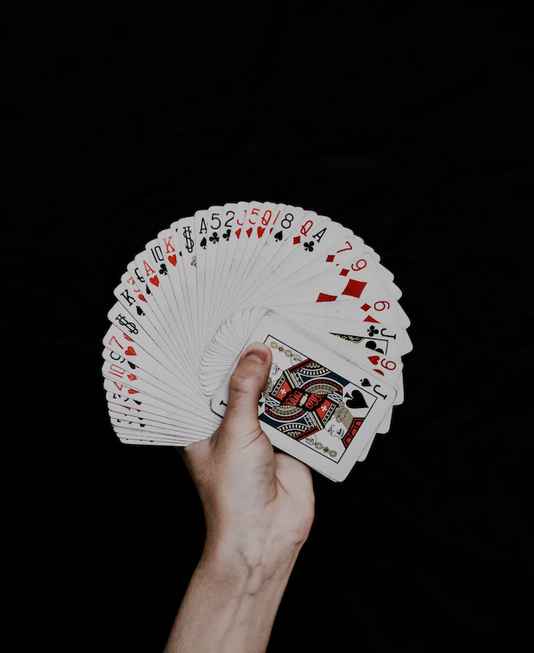
Uma mão consiste em cinco cartas, sendo que são bastam quatro ou menos para vencer o pote. As mãos de póquer são classificadas em função da sua força, das mais fortes para as mais fracas. Estas combinações de cartas e regras formam a hierarquia das mãos de póquer. Damos-lhe a lista das mãos de póquer possíveis e a sua classificação:
Royal Flush – Cartas do mesmo naipe em ordem sequencial (10♦, J♦, Q♦, K♦, A♦)
Straight Flush – quaisquer cinco cartas em ordem sequencial do mesmo naipe (5♣, 6♣, 7♣, 8♣, 9♣)
Four of a Kind – quatro cartas com o mesmo valor e de naipes diferentes, e uma carta adicional de qualquer valor (A♥, A♠, A♦, A♣, J♦)
Full House – três cartas de naipes diferentes com o mesmo valor, e um par (K♦, K♣, K♥, A♠, A♣)
Flush – quaisquer cinco cartas do mesmo naipe, mas não em ordem sequencial (A♠, 2♠, 5♠, 8♠, J♠)
Sequência – cinco cartas em sequência de diferentes naipes (2♦, 3♠, 4♥, 5♣, 6♠)
Trio – três cartas com o mesmo valor, mais duas cartas adicionais de qualquer valor (A♣, A♥, A♠, 6♦, 10♠)
Dois pares – dois pares e uma carta adicional de qualquer valor (9♣, 9♦, 5♣, 5♥, J♠)
Um par – um par e três outras cartas de qualquer valor (A♥, A♠, J♦, 8♣, 4♥)
Carta mais alta – qualquer carta que tenha na mão que seja a mais forte da mesa, e quatro cartas adicionais de qualquer valor (A♥, 8♠, 6♦, 4♣, 3♠)
Esta é a lista das principais combinações no póquer, mas elas não se ficam por aqui. Na verdade, há 1.326 possibilidades de combinações pra jogos de duas cartas “hole” no Texas Hold’em. Como sabemos, existem quatro naipes, 13 pares, e 78 mãos possíveis com naipes. Por isso, poderá obter um par de ases como mão mais elevada de entre as “hole carde”, e a pior seria um 3 e um 2.
Isto significa que terá de conseguir reconhecer as mãos fortes e fracas logo à partida. Porquê? Porque isso irá poupar-lhe tempo e dinheiro para jogar mãos melhores e vencer. Claro que, naturalmente, existem exceções à regra. No póquer tudo conta, desde o sítio onde se senta até à sua mão, assim como a pressão psicológica durante o flop, turn e river, a quantidade de fichas em jogo, e as restantes dinâmicas da mesa que tornam tudo entusiasmante.
Um Olhar Aprofundado Sobre a História das Fichas de Póquer
Olhamos para as fichas de póquer como um simples token com valor específico. Contudo, a criação das fichas começou em finais de 1800 como forma de criar pagamentos standard e flexíveis. Desde então que foram adotados pelos restantes Estados americanos, e especialmente nos casinos de Las Vegas.
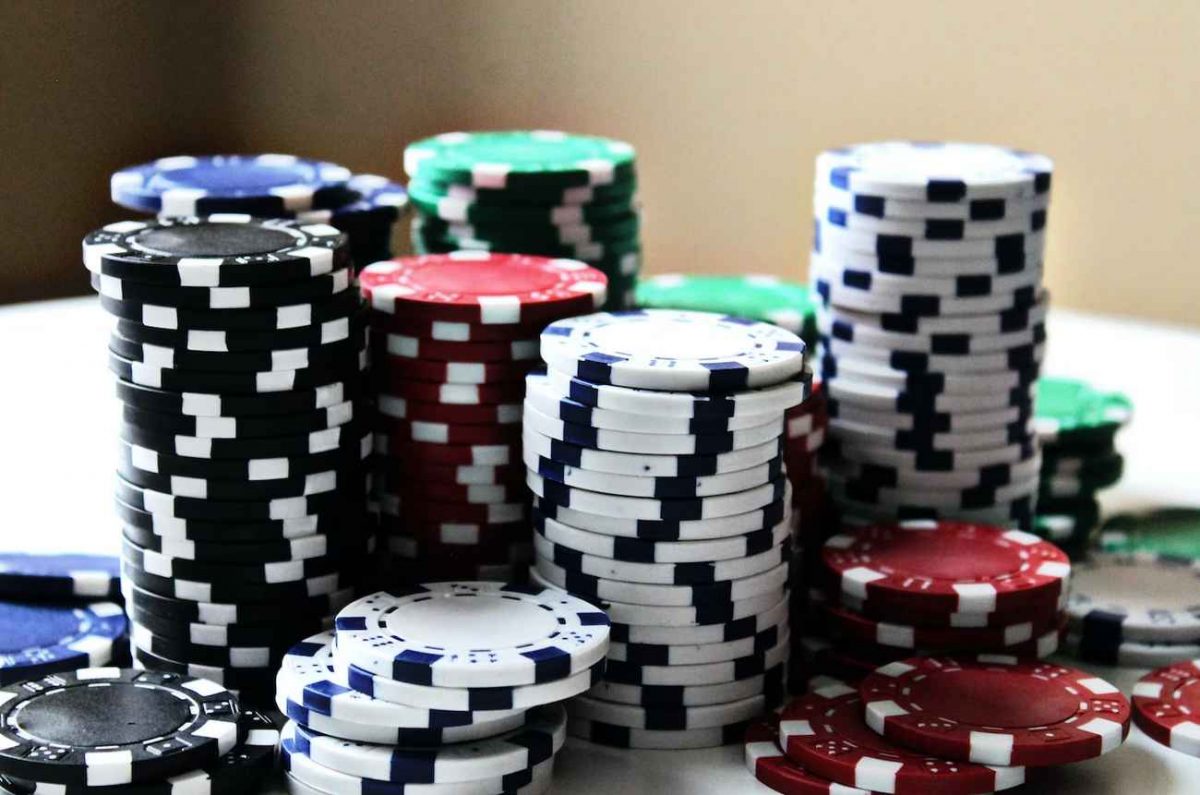
Quando olhamos para as fichas de casino, vemos que elas têm uma marca e que têm várias cores, com uma denominação no centro. Fora do âmbito dos casinos, as suas cores muitas vezes levantam dúvidas aos iniciados do póquer.
Então o significam as cores de uma série de fichas de póquer? A maior parte das séries de fichas em cash games têm valor predeterminado. Só ocasionalmente encontrará diferentes cores para as denominações mais elevadas:
- Branco – $1
- Vermelho – $5
- Laranja – $10
- Amarelo – $20
- Verde – $25
- Preto – $100
- Roxo – $500
- Vermelho escuro – $1,000
Contudo, nos torneios de póquer, esta denominação é ligeiramente diferentes. As várias cores significam o seguinte:
- Branco – $25
- Vermelho – $50
- Laranja – $100
- Amarelo – $500
- Verde – $1,000
- Preto – $5,000
- Roxo – $10,000
Durante os jogos de paradas elevadas, o valor das fichas pode subir ainda mais, para montantes de $5.000 até $100.000. As fichas são usadas para maior conveniência de apostas, representando o valor do dinheiro, mas todas são do mesmo tamanho e só as cores permitem diferenciá-las. Os casinos usam sistemas de monitorização do jogo para garantir que não há possibilidade de batota, com contagens certas e rastreamento de apostas durante os jogos de póquer.
Como Jogar Póquer – Regras Básicas que os Iniciados Precisam de Saber
Se quer aprender a jogar póquer, deve considerar o jogo como um jogo de habilidade ou um hobby. A não ser que tente melhorar continuamente, o mais provável é acabar sem orçamento. Ainda que seja essencial dominar as regras do jogo de póquer, também é importante saber como melhorar. Há milhares de pequenos fatores a ter em conta, com limitações e leituras da mesa que poderão dar vantagem contra um adversário.
Vamos começar por observar as regras e depois avançaremos para dicas que poderão melhorar o seu jogo ao longo do tempo. A primeira coisa que deve saber quando joga póquer é quantos tipos de jogos de póquer existem. Os tipos mais comuns são o Texas Hold’em, Omaha, 7-Card Stud, Five-card draw, e Short Deck.
Também deve saber que cada jogo tem o seu próprio número de regras e de estruturas de apostas que são únicas a cada estilo de jogo. Isso inclui o número de cartas dadas, o número de jogadores, as opções de apostas, e o conjunto de regras específicas.
Para explorarmos estas noções, vamos agora examinar o jogo mais popular de póquer: Texas Hold’em.
Como Jogar Póquer para Iniciados – Texas Hold ‘em
Se já conhece as regras básicas do póquer, então estará familiarizado com as várias rondas de apostas e com as regras simples que são praticadas. Contudo, muitos jogadores iniciados precisam de algum tipo de clarificação sobre como decorrem estas rondas, porque há muito jargão de póquer diretamente relacionado com as mãos jogadas. Estes são os motivos por que o póquer é muitsa vezes mal compreendido pelas pessoas. Não é propriamente de um grau de dificuldade extremo, mas para começar a jogar deve dominar ainda assim algum jargão e regras.
Vamos começar com o número de jogadores na mesa. O Texas Hold’em pode contar com mesas entre dois a dez jogadores. Contudo, também vê mesas com seis e nove jogadores em torneios de póquer, excluindo o lugar do dealer. O dealer não joga mas desempenha um papel fundamental num jogo de póquer. O objetivo do dealer é controlar a regularidade do jogo e das apostas, garantindo que tudo decorre com normalidade.
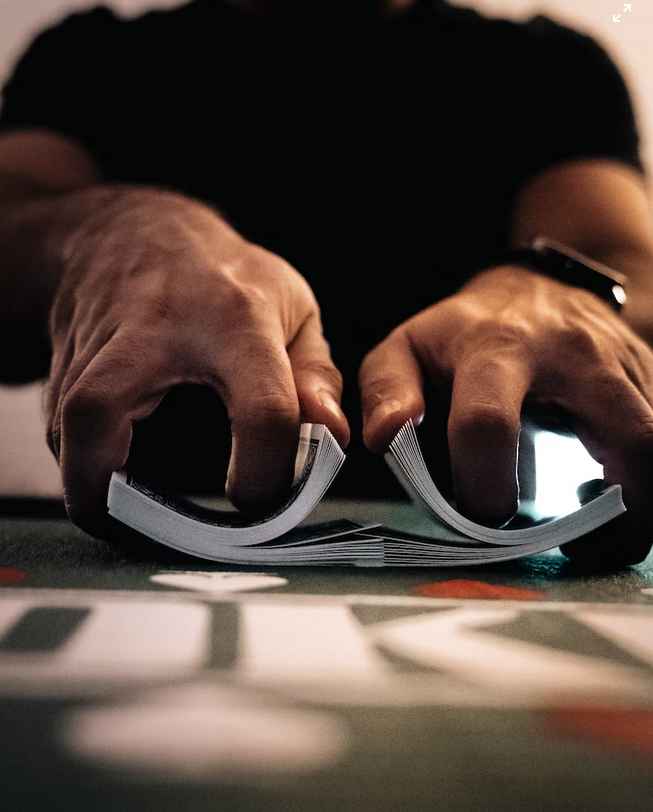
Assim, quer jogue com amigos ou num casino, haverá sempre um dealer designado para a sua mesa. Se jogar póquer em casa, o botão do dealer é passado de jogador a jogador, em direção dos ponteiros do relógio desde o início do jogo. Isto significa que as duas pessoas sentadas ao lado do dealer são as chamadas small blind (à esquerda do dealer) e big blind (sentada à esquerda da small blind).
Porque é importante saber isto? Porque estas são as pessoas que começam e terminam as apostas numa ronda. Elas devem colocar a sua aposta no pote (no centro da mesa). As probabilidades de lhe calhar uma ou outra posição são determinadas aleatoriamente quando se junta a uma mesa, e os pagamentos são em função do buy-in. Por exemplo, a small blind poderá requerer uma ficha de $5, e a big blind uma ficha de $10 antes de ir a jogo.
Depois de a aposta ter sido colocada, o dealer dará duas cartas viradas para baixo a cada jogador, em ordem da direção dos ponteiros do relógio. Primeiro dá uma carta a todos, e depois novamente mais uma a todos. A razão para as cartas serem dadas com a face virada para baixo é por que só o jogador que as recebe é que as pode ver. Elas permanecem assim, viradas para baixo, até ao final do jogo.
Esta é chamada a fase blind, porque ninguém sabe quais foram as cartas da comunidade que foram dadas. A única certeza é o valor das duas cartas que recebeu na sua mão. O primeiro jogador a poder agir é o da big blind, e aqui é importante ponderar o que fazer:
Equiparar a big blind – apostar o mesmo montante da big blind na mesa ou no pote da comunidade.
Check – significa dar à pessoa à esua esquerda a possibilidade de dicidir o grau de ação nessa ronda, ou seja, poderá não apostar ou colocar uma aposta. Se os restantes jogadores quiserem fazer “check”, ninguém apostará e é o fim da presente ronda.
Aumentar a big blind – Aumentar o valor da big blind de $10 e forçar os outros jogadores a equipararem a aposta ou desistir.
Ir all-in – se um jogador decidir fazer all-in, ele estará a colocar todas as suas fichas no centro da mesa. Isto cria tensão jufnto dos outros jogadores, uma vez que para irem a jogo terão de comprometer uma grande percentagem das suas fichas ou então desistir. Isto acontece frequentemente com jogadores de apostas elevadas, que são frequentes em torneios. Como jogador iniciado, é importante saber quando desistir se houver um grau de apostas muito elevado na mesa.
Desistir da mão – Se optar por desistir (fazer “fold), o jogador não tem de apostar nada, considerando que tem uma mão fraca. Por outras palavras, o jogador terá de lançar as suas cartas para o centro da mesa, sinalizando ao dealer a sua intenção de não ir a jogo.
A ronda de apostas continua para a small blind, e agora há que decidir se vale a pena equiparar a big blind ou aumentar a aposta. A mesma regra aplica-se à big blind, tendo em conta a ação do último jogador da ronda. Quando um jogador decide aumentar a aposta, há uma nova ronda de apostas que se inicia em sentido dos ponteiros do relógio.
Assim que essa ronda de apostas estiver completada, a próxima fase que se inicia é a do flop. Antes de o dealer colocar três cartas da comunidade viradas para cima na mesa, ele retira uma das cartas do topo do baralho e remove-a. Esta é uma regra que permite garantir a aleatoriedade do jogo. Por outras palavras, o flop consistente de um conjunto de cartsa da comunidade que qualquer jogador pode usar para constituir a sua mão.
A segunda ronda de apostas começa em sentido dos ponteiros do relógio a partir do dealer. O primeiro jogador age, e se ele decidir colocar uma aposta, o mínimo permitido será o valor da big blind, neste caso é de $10.
Antes da terceira fase, o dealer remove uma nova carta do baralho. A terceira ronda é chamada de turn, e o dealer coloca a quarta carta da comunidade na mesa. Isto significa que se dará início a uma nova ronda de apostas.
Chegamos então à quarta ronda, com a quinta carta da comunidade a ser colocada no centro da mesa. Mas antes disso, o dealer queima nova carta do topo do baralho. A última carta colocada na mesa é chamada de river. Depois disso, uma derradeira ronda de apostas tem lugar.
Depois da última aposta vem a quinta e a última ronda do jogo, chamada de showdown. Esta ronda inicia-se com o jogador à esquerda do dealer, que vira as suas cartas e mostra a sua mão. O último jogador poderá mostrar o seu jogo ou decidir desistir sem revelar a mão. O jogador com a mão mais alta que tiver sido revelada ganha o pote. Isto termina o jogo, com o vencedor a ganhar o valor acumulado do pote. Depois disso, os jogadores podem decidir jogar um novo jogo ou sair.
Dicas para Jogar Póquer
Como se costuma dizer, antes da mestria vem a prática. Quanto mais jogar, melhor jogador se torna. O conhecimento que obtém da experiência de jogo é importante, e os jogadores iniciados devem prestar especial atenção à sua aprendizagem sobre as componentes sociais e psicológicas do póquer. Por exemplo, se alguém se senta ao seu lado, ele poderá tirar melhor partido do bluff ou da leitura atenta da sua linguagem corporal. De uma forma ou de outra, estará a passar informação subtil que poderá revelar a força da sua mão, mesmo que ainda não se tenha chegado ao showdown.
Para tornar as coisas mais simples, deixamos aqui uma lista de dicas que o ajudarão a ser melhor no póquer.
- Conheça as regras do jogo
- Não tem de jogar todas as mãos
- Permaneça calmo durante uma partida de póquer
- Tenha atenção ao seu lugar na mesa
- Jogue com inteligência e tome o seu tempo para pensar antes de cada mão
- Desista sempre que isso faça sentido
- Não revele as suas cartas no showdown a menos que vença
- Pratique em mesas de póquer online
- Aposte apenas o que estiver preparado para perder
Teste o seu conhecimento de póquer e aprenda com jogadores de póquer profissionais na Coinpoker
Póquer Online ou Póquer ao Vivo: Qual a Melhor Escolha?
Logo que alguém menciona a sua participação em póquer online, muitas pessoas pensam em bots ou formas de batota. Contudo, isso raramente acontece. Há milhares de salas de póquer online, onde há jogadores verificados e transparência nas apostas. Deixamos-lhe alguns motivos por que apostar em salas de póquer online faz sentido:
- Jogue contra pessoas reais: Jogar póquer com outras pessoas é mais divertido. Poderá conversar sobre o jogo com os seus adversários, o que é muito mais divertido do que olhar para um ecrã de computador.
- Aprenda com os melhores: Jogar póquer online irá permitir-lhe observar o jogo de outros jogadores que são melhores do que você. Eles poderão revelar ótimas jogadas e estratégias para benefício de quem os observe!
- Joguem sempre que quiser, onde quiser: Poderá jogar de dia ou de noite, porque não há limitações físicas sobre o momento em que pode jogar. Basta fazer log in no seu computador e começar a jogar.
- Ganhe dinheiro real: Algumas pessoas ficam desmotivadas com jogo baseado em créditos sem ligação a dinheiro. Tudo se torna muito mais entusiasmado se as apostas forem feitas com dinheiro real.
- Jogue com os melhores: Não há nada mais entusiasmante do que encontrar-se com alguém que jogue póquer. As salas de póquer online são um lugar para outras pessoas que querem desafios a dinheiro real.
Em Resumo
Garanta que se sente confiante sobre as várias classificações de mãos de póquer, que sabe como jogar antes de se juntar a uma mesa. Uma pesquisa prévia e atenta poderá levá-lo longe para o sucesso no jogo de póquer.
Uma das coisas mais importantes a ter em mente é saber que o jogo de póquer é feito para que todos se divirtam. Assim, poderá desfrutrar de jogos mesmo que apenas ganhe ocasionalmente. O objetivo é passar um bom bocado ao mesmo tempo que melhora as suas capacidades de jogo. Assim, ao longo do tempo, tornar-se-á mais consistente com as suas vitórias.
Este guia deverá ajudá-lo a focar-se nos detalhes mais importantes das mãos de póquer, nas fichas, e nas regras, dando-lhe uma vantagem para o seu primeiro jogo de póquer. E assim que começar a jogar, a confiança e o seu estilo de jogo poderão desenvolver-se mais facilmente.














